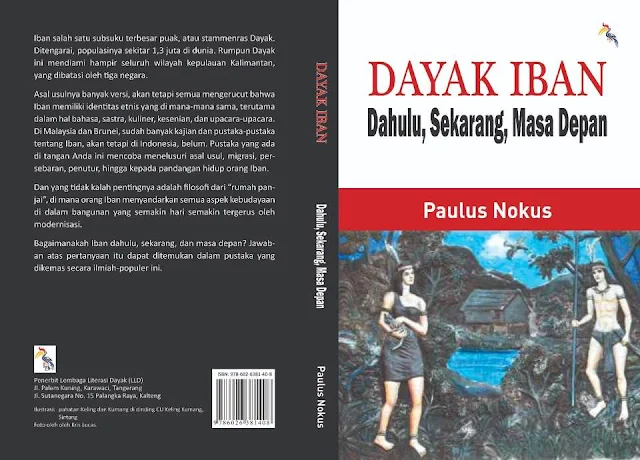 |
| Book cover by: Author. |
Book Title: Dayak Iban
Dahulu, Sekarang, Masa Depan - Dayak Iban: Past, Present, and Future
Author: Paulus Nokus
First Edition, Tangerang: Lembaga Literasi Dayak, 2018
viii + 153 pages, 14 x 21 cm
ISBN: 978-602-6381-53-8
Published by Lembaga Literasi Dayak
Cover Design/Layout: Diddy S.
What are the defining characteristics of the Dayak Iban? This book provides the answers in considerable detail.
One of them is language. Wherever they are, the Iban people understand the Iban language, although migration and interactions with other ethnic groups in new areas have gradually influenced its dialects. However, on average, the roots of the Iban language remain the same. For instance, people from Sungai Utik, Mualang, and Tapang Sambas in West Kalimantan can understand the Iban dialect in Sarawak quite well.
Despite being scattered across various regions such as Malaysia, Brunei Darussalam, and Indonesia, they maintain a common cultural pattern. Their traditional customs are upheld with great reverence. “Betungkat ke adat basa, bepegai ke pengator pekara” (Uphold traditional customs, adhere to established principles).
The Iban is one of the largest sub-tribes of the Dayak ethnic group. It is estimated that their population is around 1.3 million globally. The Dayak ethnic group inhabits almost the entire Kalimantan archipelago, which spans three nations.
The origins of the Iban people have multiple versions, but all converge on the idea that the Iban possess a distinct ethnic identity that is consistent everywhere, particularly in language, literature, cuisine, art, and rituals. While many studies and literature on the Iban exist in Malaysia and Brunei, this is not the case in Indonesia. The book in your hands aims to explore the origins, migration, distribution, language speakers, and worldview of the Iban people.
Equally significant is the philosophy of the rumah panjai (longhouse), which embodies all aspects of their culture within its structure—a tradition increasingly challenged by the tide of modernization.
What about the Iban in the past, the present, and the future? The answers to these questions can be found in this scientifically yet popularly written book.
The Spread of the Iban Dayak People
The term Iban originates from the Kayan word ivan, meaning "wanderer." The Iban people are a subgroup of the Dayak community residing in the southwestern part of Borneo. Most Iban live in Sarawak, while others inhabit the upper reaches of the Kapuas River. In West Kalimantan, the Iban Dayak community is concentrated in Batang Lupar Lanjak District and Embaloh Hulu District of Kapuas Hulu Regency.
Many still live in traditional longhouses. They are also found along the border areas of Kapuas Hulu Regency and Sarawak, Malaysia, including Puring Kencana, Empanang, Badau, Lanjak, and Embaloh Hulu districts, as well as in Seluas District, Bengkayang Regency (originating from Seremat Hamlet, Lubok Antu District), and Sintang Regency.
When discussing the Iban subgroups (Ibanic Group), there are 14 subspecies, including the Kantuk, Seberuang, Ketungau, and Mualang, among others, which are unified under the Tampun Juah Association (led by Tobias Ranggie, SH). According to oral tradition and history, the Iban people migrated to Kalimantan in stages. Benedict Sadin recorded that the ancestors of the Iban may have originally lived in the Middle East, migrated to Sumatra, and eventually settled on the island of Borneo. They lived in the Kapuas River valley for an extended period.
Whether the oral traditions of the Iban suggest a physical migration from the Middle East or merely cultural influences remains a topic of debate among researchers of the Iban Dayak. At a seminar in Miri (1984), some papers did not specify the Iban’s origins but identified them as the indigenous inhabitants of Borneo. According to one story, when the first Europeans arrived in Borneo, they saw people drinking coconut water. When asked what it was, the locals replied buah nyiur (coconut water). From this, the name "Borneo" is thought to have originated. Another theory suggests the Iban came from Yunnan or Burma, citing similarities in physical traits and culture.
The widely accepted view is that the Iban people living in Sarawak originated from West Kalimantan, Indonesia. Migration to Sarawak began approximately fifteen generations ago, around the 16th century. This migration started along the Kapuas River, continued along the Batang Lupar River, and led to settlements on the banks of the Undup River in Sarawak, bordering Puring Kencana District, Kapuas Hulu Regency. After five generations, the pioneers moved north, east, and west, occupying all the major rivers in Sarawak, including those in Brunei Darussalam.
The Difference Between Iban Groups and Subgroups
Before describing the profile of the Iban Dayak and their culture, it is important to distinguish between the Iban as an ethnic group and the Iban as a subgroup. The term Ibanic Groups refers to a broader collection of subgroups such as Iban, Mualang, Kantuk (Kantu’), Ketungau, Banyur, Desa, and Seberuang. These groups are spread across three countries: Indonesia, Malaysia, and Brunei Darussalam. In Indonesia, they inhabit seven regencies: Kapuas Hulu, Bengkayang, Sambas, Sintang, Melawi, Sanggau, and Sekadau. Meanwhile, the term Dayak Iban refers specifically to one subgroup within the larger Iban group.
The Iban subgroup is one of the largest within the Ibanic Groups. The Dayak Iban community spans two countries, Indonesia and Malaysia. In Indonesia, the Iban Dayak primarily reside in Kapuas Hulu Regency, scattered across six districts: Putussibau, Embaloh Hulu, Batang Lupar, Badau, Empanang, and Puring Kencana.
Although not comprehensive, this book provides a sufficient overview of the Iban ethnic group and its at least 24 subgroups. The Iban represent the largest Dayak population in the world today, with a number reaching no less than 1.2 million people.
-- Rangkaya Badaa

Posting Komentar